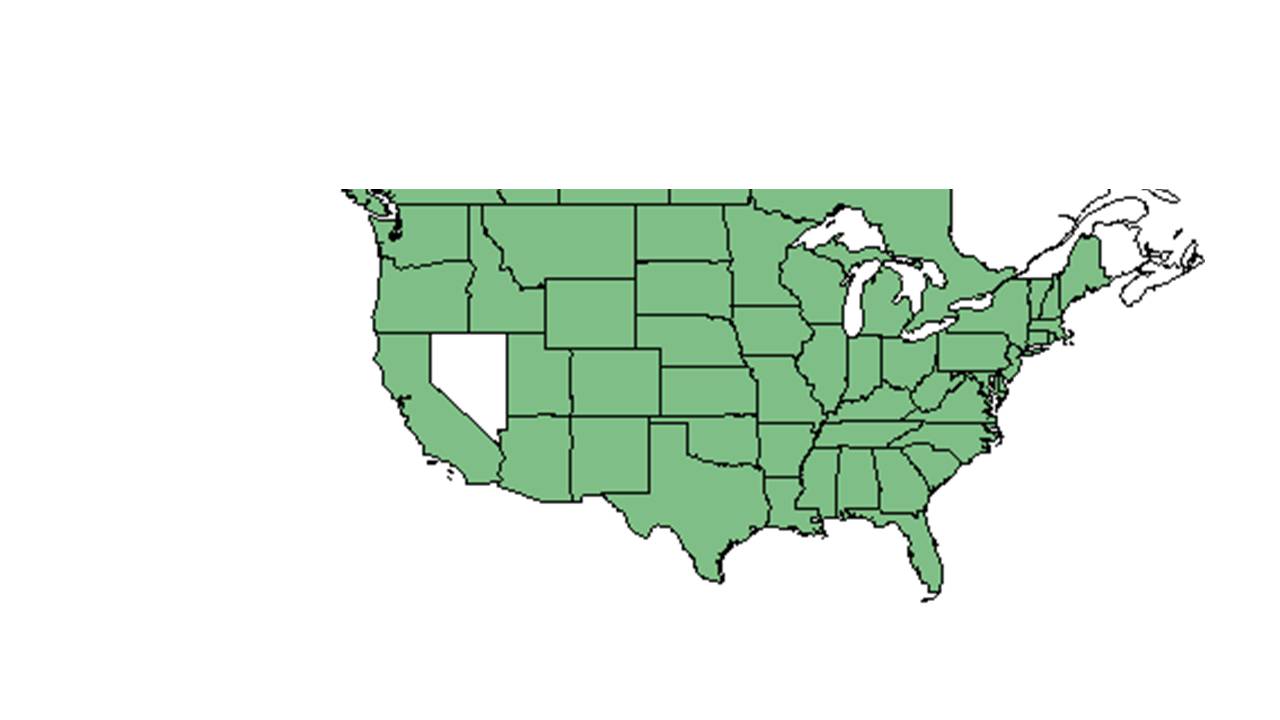Dichanthelium oligosanthes
| Dichanthelium oligosanthes | |
|---|---|
Error creating thumbnail: Unable to save thumbnail to destination
| |
| Scientific classification | |
| Kingdom: | Plantae |
| Division: | Magnoliophyta - Flowering plants |
| Class: | Liliopsida – Monocotyledons |
| Order: | Cyperales |
| Family: | Poaceae ⁄ Gramineae |
| Genus: | Dichanthelium |
| Species: | D. oligosanthes |
| Binomial name | |
| Dichanthelium oligosanthes (Schult.) Gould | |

| |
| Natural range of Dichanthelium oligosanthes from USDA NRCS Plants Database. | |
Contents
Description
Common Name: Heller's rosette grass
Synonym Name: Panicum oligosanthes Schult.
Dichanthelium oligosanthes is a perennial graminoid. It tends to form dense tussocks of many stems (FSU Herbarium).
Distribution
Ecology
Habitat
It can live in Foard and Lawton soils, which are both grassland soils.[1] D. oligosanthes var. scribnerianum can tolerate hot summers, cold winters, minimal precipitation (826 mm per year), and moderately strong surface winds.[2] It seems to prefer light levels between open sun and partial shade (FSU Herbarium).
This species can be found in undisturbed areas.[3] It is commonly found in open woodlands[4] and tallgrass prairies.[2] D. oligosanthes also occurs in oak-pine flats, limestone glades, sand plains, loblolly pine forests, upland pine woods, and oak hammocks (FSU Herbarium). However, it can also be found in disturbed habitat like cut over pine woods, cultivated and old fields, roadsides, railways, and disturbed prairies (FSU Herbarium).
Phenology
It flowers from early to mid season.[5]
Flowering has been observed in May, while fruiting has been observed in March, May, and June (FSU Herbarium).
Seed dispersal
Fire seems to stimulate the seed bank.[4]
Seed bank and germination
Fire ecology
It responds positively to fire. It increased in distribution and abundance following an early dormant-season fire.[4] Dichanthelium oligosanthes var. scribnerianum found in uplands and lowlands responded positively to summer burns but negatively to spring burns in the long run (more than 10 years). However, D. oligosanthes found in the canopy cover declined with both burns.[2]
Pollination
Use by animals
Diseases and parasites
Conservation and Management
Cultivation and restoration
Photo Gallery
References and notes
Florida State University Robert K. Godfrey Herbarium database. URL: http://herbarium.bio.fsu.edu. Last accessed: June 2014.
Collectors: L.C. Anderson, Wilson Baker, R. Kral, M. Nee, E. D. Cappel, Riedeman, H. L. Blomquist, Harry E. Ahles, D. S. Correll, Duane Isely, S L Welsh, Dwight Isely, S. W. Leonard, A. E. Radford, H. R. Reed, T. MacClendon, K. MacClendon, Robert F. Thorne, James R. Burkhalter, R.K. Godfrey, Kurz, A. H. Curtiss, A. P. Anderson, Pat Howell, Brenda Thomas, George Wilder, F. Lyle Wynd, C. H. Mueller, Robert L. Lazor, and Raymond Athey.
States and Counties: Florida: Calhoun, Duval, Escambia, Gadsden, Franklin, Jackson, Jefferson, Leon, Liberty, Okaloosa, and Suwannee. Georgia: Seminole. Kentucky: Caldwell, Livingston, and Logan. Louisiana: Ouachita. Mississippi: Pearl River. North Carolina: Moore, Cumberland, and Pender. South Carolina: Orangeburg. Texas: Bexar, Freestone, Tarrant, and Van Zandt. Virginia: Giles. Wisconsin: Richland.
Other Countries: Mexico
- ↑ Leis, S. A., D. M. Engle, et al. (2005). "Effects of short- and long-term disturbance resulting from military maneuvers on vegetation and soils in a mixed prairie area." Environmental Management 36: 849-861.
- ↑ 2.0 2.1 2.2 Towne, E. G. and K. E. Kemp (2008). "Long-term response patterns of tallgrass prairie to frequent summer burning." Rangeland Ecology & Management 61: 509-520.
- ↑ Jutila, H. M. and J. B. Grace (2002). "Effects of disturbance on germination and seedling establishment in a coastal prairie grassland: a test of the competitive release hypothesis." Journal of Ecology 90: 291-302; Towne, E. G. and K. E. Kemp (2008). "Long-term response patterns of tallgrass prairie to frequent summer burning." Rangeland Ecology & Management 61: 509-520.
- ↑ 4.0 4.1 4.2 Taft, J. B. (2003). "Fire effects on community structure, composition, and diversity in a dry sandstone barrens." Journal of the Torrey Botanical Society 130: 170-192.
- ↑ Pavlovic, N. B., S. A. Leicht-Young, et al. (2011). "Short-term effects of burn season on flowering phenology of savanna plants." Plant Ecology 212: 611-625.